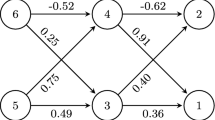Abstract
The standard definition of causal Bayesian networks (CBNs) invokes a global condition according to which the distribution resulting from any intervention can be decomposed into a truncated product dictated by its respective mutilated subgraph. We analyze alternative formulations which emphasizes local aspects of the causal process and can serve therefore as more meaningful criteria for coherence testing and network construction. We first examine a definition based on “modularity” and prove its equivalence to the global definition. We then introduce two new definitions, the first interprets the missing edges in the graph, and the second interprets “zero direct effect” (i.e., ceteris paribus). We show that these formulations are equivalent but carry different semantic content.
This work was supported in parts by National Institutes of Health #1R01 LM009961-01, National Science Foundation #IIS-0914211 and #IIS-1018922, and Office of Naval Research #N000-14-09-1-0665 and #N00014-10-1-0933.
Access this chapter
Tax calculation will be finalised at checkout
Purchases are for personal use only
Preview
Unable to display preview. Download preview PDF.
Similar content being viewed by others
References
Dawid, A.P.: Influence diagrams for causal modelling and inference. International Statistical Review 70(2), 161–189 (2001)
Galles, D., Pearl, J.: An axiomatic characterization of causal counterfactuals. Foundation of Science 3(1), 151–182 (1998)
Geiger, D., Verma, T.S., Pearl, J.: Identifying independence in Bayesian networks. Networks 20, 507–534 (1990)
Halpern, J.Y.: Axiomatizing causal reasoning. In: Cooper, G.F., Moral, S. (eds.) Uncertainty in Artificial Intelligence, pp. 202–210. Morgan Kaufmann, San Francisco (1998); Also, Journal of Artificial Intelligence Research 12(3), 17–37 (2000)
Heckerman, D., Shachter, R.: Decision-theoretic foundations for causal reasoning. Journal of Artificial Intelligence Research 3, 405–430 (1995)
Koller, D., Friedman, N.: Probabilistic Graphical Models: Principles and Techniques. MIT Press (2009)
Lauritzen, S.L.: Graphical Models. Clarendon Press, Oxford (1996)
Lauritzen, S.L.: Causal inference from graphical models. In: Complex Stochastic Systems, pp. 63–107. Chapman and Hall/CRC Press (1999)
Lindley, D.V.: Seeing and doing: The concept of causation. International Statistical Review 70, 191–214 (2002)
Pearl, J., Verma, T.: The logic of representing dependencies by directed acyclic graphs. In: Proceedings of the Sixth National Conference on AI (AAAI 1987), Seattle, WA, pp. 374–379 (July 1987)
Pearl, J.: Probabilistic Reasoning in Intelligent Systems. Morgan Kaufmann, San Mateo (1988)
Pearl, J.: Belief networks revisited. Artificial Intelligence 59, 49–56 (1993)
Pearl, J.: A probabilistic calculus of actions. In: Lopez de Mantaras, R., Poole, D. (eds.) Uncertainty in Artificial Intelligence 10, pp. 454–462. Morgan Kaufmann, San Mateo (1994)
Pearl, J.: Causality: Models, Reasoning, and Inference. Cambridge University Press, New York (2000); 2nd edn. (2009)
Pearl, J.: Causality: Models, Reasoning, and Inference, 2nd edn. Cambridge University Press, New York (2009)
Robins, J.M.: A new approach to causal inference in mortality studies with a sustained exposure period – applications to control of the healthy workers survivor effect. Mathematical Modeling 7, 1393–1512 (1986)
Spirtes, P., Glymour, C.N., Scheines, R.: Causation, Prediction, and Search. Springer, New York (1993)
Tian, J., Pearl, J.: A new characterization of the experimental implications of causal Bayesian networks. In: Proceedings of the Eighteenth National Conference on Artificial Intelligence, pp. 574–579. AAAI Press/The MIT Press, Menlo Park, CA (2002)
Tian, J., Kang, C., Pearl, J.: A characterization of interventional distributions in semi-Markovian causal models. In: Proceedings of the Twenty-First National Conference on Artificial Intelligence, pp. 1239–1244. AAAI Press, Menlo Park (2006)
Author information
Authors and Affiliations
Editor information
Editors and Affiliations
Rights and permissions
Copyright information
© 2012 Springer-Verlag Berlin Heidelberg
About this paper
Cite this paper
Bareinboim, E., Brito, C., Pearl, J. (2012). Local Characterizations of Causal Bayesian Networks. In: Croitoru, M., Rudolph, S., Wilson, N., Howse, J., Corby, O. (eds) Graph Structures for Knowledge Representation and Reasoning. Lecture Notes in Computer Science(), vol 7205. Springer, Berlin, Heidelberg. https://doi.org/10.1007/978-3-642-29449-5_1
Download citation
DOI: https://doi.org/10.1007/978-3-642-29449-5_1
Publisher Name: Springer, Berlin, Heidelberg
Print ISBN: 978-3-642-29448-8
Online ISBN: 978-3-642-29449-5
eBook Packages: Computer ScienceComputer Science (R0)




